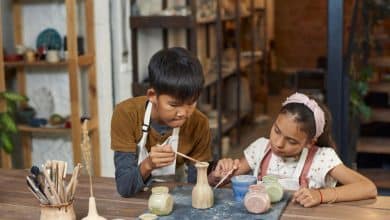Embrace Eco-Chic: Exploring Green Fashion Brands And Designers

Are you tired of fashion brands that prioritize profit over the planet? Do you want to make a difference with your purchases and support environmentally responsible options? Look no further than green fashion brands and designers.
As conscious consumers, it’s our responsibility to choose sustainable options in all aspects of our lives, including fashion. Green fashion encompasses everything from using eco-friendly materials to implementing ethical production practices. By choosing green fashion brands and designers, we can reduce our impact on the environment while still looking stylish. In this article, we’ll explore the benefits of choosing these options and highlight some small independent designers as well as established brands leading the charge in the industry.
Key Takeaways
- Green fashion brands prioritize sustainability and eco-friendly clothing options.
- Sustainable fashion utilizes natural dyes and processes, prioritizes fair labor practices, and emphasizes durability and longevity.
- Supporting small independent labels promotes creativity and diversity in the industry.
- Luxury sustainable fashion brands implement ethical practices throughout their supply chains.
What is Green Fashion?

You might be wondering, what’s green fashion all about? It’s all about sustainability in fashion and using eco-friendly clothing options. As we become more aware of the impact that our choices have on the environment, it is important to also consider the materials used in making our clothes. Green fashion brands and designers are taking a stand by prioritizing sustainability and creating fashionable pieces that don’t harm our planet.
Sustainability in fashion means using environmentally friendly materials such as organic cotton, hemp, bamboo, and recycled fabrics. These materials require less water usage during production and do not contain harmful chemicals that can damage the environment. Eco-friendly clothing options also include upcycling or repurposing old clothes into new pieces rather than buying new ones.
Choosing green fashion brands and designers has many benefits beyond just being good for the environment. By supporting sustainable brands, you are promoting fair labor practices in the production of clothing. Many green fashion companies prioritize ethical working conditions for their employees by paying them a living wage and ensuring safe working environments.
In addition to being socially responsible consumers, choosing green fashion brands and designers can also benefit your personal style. These brands often create unique pieces that incorporate sustainable materials while still keeping up with current trends. You can be stylish while still making conscious choices for a better world.
By choosing to support green fashion brands and designers, you’re not only helping preserve our planet but also contributing to ethical business practices while staying trendy at the same time.
Benefits of Choosing Green Fashion Brands and Designers
Opting for sustainable and eco-friendly options in the fashion industry can lead to a variety of advantages, including reduced environmental impact and improved social responsibility. As consumers, we have the power to make informed decisions about where we shop and what we wear. By choosing green fashion brands that prioritize sustainability impact and ethical production, we not only support environmentally friendly practices but also send a message to larger companies that there is demand for more responsible manufacturing.
To better understand the benefits of choosing green fashion brands, let’s take a look at this table comparing conventional fashion with its sustainable counterpart:
| Conventional Fashion | Sustainable Fashion |
|---|---|
| Uses toxic chemicals in production | Utilizes natural dyes and processes |
| Often produced under poor working conditions | Prioritizes fair labor practices |
| Fast-fashion model leads to excessive waste | Emphasizes durability and longevity |
As you can see, opting for sustainable fashion can have a positive impact on both people and the planet. By using natural materials and processes, these brands minimize their carbon footprint while also avoiding harmful toxins. Moreover, they often prioritize fair labor practices by providing safe working environments and living wages.
At the end of the day, choosing green fashion isn’t just about looking good – it’s about feeling good too. When you wear clothes from sustainable brands, you know that you’re supporting ethical production methods that benefit both workers and the environment. And as more consumers choose these options over fast-fashion alternatives, we collectively work towards creating a more responsible industry overall.
So why not give it a try? Next time you’re on the hunt for new clothing items or accessories, consider shopping from one of these environmentally friendly brands. In our next section, we’ll dive deeper into another category of designers: small independent labels who are putting their unique stamp on sustainable fashion.
Small Independent Designers

Supporting small independent labels in sustainable clothing production allows for unique, creative designs that prioritize ethical and eco-friendly practices. These designers often collaborate with artisans from local communities to create one-of-a-kind pieces that are not only stylish but also support traditional craftsmanship and fair labor practices.
Additionally, small independent designers tend to use sustainable production techniques such as upcycling, zero-waste patterns, and natural dyeing processes. By avoiding harmful chemicals and reducing waste throughout the manufacturing process, these brands are able to reduce their environmental impact while producing high-quality garments.
Not only do these green fashion brands make a positive impact on the environment and local communities, but they also provide consumers with an opportunity to express their individuality through fashion. By supporting smaller labels instead of buying mass-produced items from fast fashion companies, we are able to reduce our overall carbon footprint while promoting creativity and diversity in the industry.
In a world where established brands dominate the market, it’s important to remember the value of supporting small businesses that prioritize sustainability. By choosing ethical and eco-friendly fashion options from smaller labels, we can make a difference both in our personal style choices and in creating a more conscious consumer culture. Moving forward, let’s continue to seek out these unique brands and celebrate their contributions towards a greener future.
Established Brands

When it comes to sustainable fashion, established brands have a long way to go. In fact, these companies are responsible for a staggering 92 million tons of textile waste each year. This massive amount of waste is a result of the fast fashion model that prioritizes cheap and trendy clothes over ethical and eco-friendly designs. However, there are some notable exceptions in the industry that are committed to sustainability.
To illustrate this point, let’s take a look at three established brands that prioritize sustainable fashion: Patagonia, Levi’s, and Adidas. Each brand has taken steps to reduce their environmental impact by using recycled materials, reducing water usage during production, and implementing ethical labor practices.
| Brand | Sustainable Practices | Eco-Friendly Designs |
|---|---|---|
| Patagonia | Uses recycled materials in clothing production; operates on fair trade principles | Offers organic cotton clothing; produces durable outdoor gear |
| Levi’s | Implements water-saving techniques in denim production; offers recycling program for old jeans | Creates sustainable collections using hemp and other eco-friendly fabrics |
| Adidas | Uses recycled polyester in clothing production; partners with Parley for Oceans to turn plastic waste into clothing | Produces vegan sneakers made from recycled ocean plastic |
These brands offer proof that it is possible for big companies to prioritize sustainability without sacrificing style or quality. By supporting these companies and others like them, we can help push the entire industry towards more ethical practices.
It’s clear that sustainable fashion is not just a passing trend – it’s here to stay. As consumers become more conscious of their impact on the environment, they’re demanding more options for eco-friendly designs across a range of styles. In the next section, we’ll explore how designers are meeting this demand with innovative and stylish solutions.
Range of Styles

As a conscious consumer, you may be pleased to know that sustainable fashion is no longer limited to one specific aesthetic or style. Sustainable fabrics and ethical production techniques have become more accessible in the fashion industry, allowing designers to incorporate these values into their collections while still maintaining their unique brand identity.
From bohemian dresses to sleek tailored suits, sustainable fashion has something for everyone. Brands like Stella McCartney and Reformation have paved the way for eco-friendly clothing with their chic designs made from recycled materials and organic cotton. You can find everything from casual basics to formal wear made sustainably.
Not only are there a plethora of styles available, but sustainable fashion also allows consumers to feel good about their purchases knowing they are supporting environmentally responsible practices. By using fabric that is ethically sourced and produced without harmful chemicals, these brands are making a positive impact on both people and the planet.
With so many options available, it’s easier than ever before to make conscious choices about what we wear. And as more designers continue to embrace sustainability in their collections, we can expect even more diversity in styles and aesthetics that align with our values. As we move forward into the next section about price points, let’s explore how affordable this new wave of sustainable fashion can be.
Price Points
Alright, guys – let’s talk price points. When it comes to sustainable fashion, there are two main categories: high-end designers and affordable options. Personally, I’m all for splurging on a timeless piece from a green luxury brand that aligns with my values, but sometimes budget constraints make it impossible. That’s why having access to more wallet-friendly eco-fashion options is crucial for making sustainable choices accessible to everyone.
High-End Designers

Luxury fashion designers are taking sustainability to the next level with their exquisitely crafted, environmentally conscious collections that are sure to take your breath away. These sustainable luxury brands and eco-friendly haute couture designers are leading the way in creating beautiful pieces while also minimizing their impact on the environment. From Stella McCartney’s innovative use of vegan leather to Gabriela Hearst’s commitment to using only certified organic materials, these high-end designers are proving that style and sustainability can coexist.
But it’s not just about the materials used – these luxury fashion brands are also implementing ethical practices throughout their supply chains. Many have created programs for recycling and reducing waste, as well as initiatives to support local communities where their products are made. It’s clear that these designers understand the importance of sustainability and are truly committed to making a positive impact on our planet. And while these collections may come with a higher price tag, they’re an investment in both style and conscience. However, if you’re looking for more affordable options without compromising on eco-friendliness, there are plenty of emerging sustainable fashion brands worth checking out.
Affordable Options

After discussing high-end designers who are making strides in the green fashion industry, let’s now talk about more affordable options that are still eco-friendly. It’s important to remember that sustainable fashion doesn’t have to be expensive. In fact, there are plenty of brands and designers out there who prioritize using eco-friendly materials and sustainable production techniques while keeping their prices accessible.
One brand that comes to mind is Reformation, a Los Angeles-based company that focuses on creating stylish clothing with a conscience. They use sustainable fabrics like TENCEL™ Lyocell and deadstock fabrics (unused fabric from other designers or manufacturers) to create their pieces. They also prioritize water conservation in their production process by using a closed-loop system for dyeing fabrics and recycling 75% of their waste. And the best part? Their price points are comparable to popular fast-fashion brands, making ethical shopping much more accessible for consumers on a budget.
As we shift towards a more conscious way of living, it’s important to consider where our clothes come from and how they’re made. By supporting affordable green fashion brands like Reformation, we can make positive changes without breaking the bank. But what exactly are some of these changes? Let’s take a look at current green fashion trends and how they’re shaping the industry as a whole.
Green Fashion Trends

We’re excited to delve into the latest green fashion trends! One of our favorites is the use of recycled materials in clothing and accessories. It’s amazing to see designers get creative with repurposing plastics, old fabrics, and even discarded fishing nets. We also love the shift towards using natural dyes instead of harsh chemicals that harm both people and the environment. And let’s not forget about upcycling – breathing new life into old clothes is a great way to reduce waste while still staying fashionable.
Use of Recycled Materials

Using recycled materials is not only environmentally responsible, but it also opens up a world of possibilities for fashion brands and designers to create unique and innovative pieces. With the increasing awareness of the environmental impact of fast fashion, more and more designers are turning to recycled material innovations to create sustainable fashion.
From using recycled plastic bottles to make clothing fibers, to transforming old denim into new jackets or bags, there are countless ways that designers are harnessing the power of recycling in their collections. Not only does this reduce waste and lessen the carbon footprint of the industry, but it also adds an element of creativity and uniqueness to each piece. As consumers become more conscious about their purchasing habits, they are drawn towards these eco-friendly options that offer something truly one-of-a-kind.
As we look towards the future of sustainable fashion, natural dyes present another exciting opportunity for brands and designers.
Natural Dyes

Natural dyes offer a unique and sustainable solution for adding vibrant colors to clothing without harming the environment. As eco-friendly alternatives become increasingly popular in the fashion industry, sustainability practices such as using natural dyes are gaining traction.
To illustrate the beauty of natural dyes, let’s take a look at this table showcasing some common plant-based sources of dye and their resulting colors:
| Plant | Color |
|---|---|
| Indigo | Blue |
| Turmeric | Yellow |
| Beetroot | Pink/Red |
| Avocado pits/skins | Peach |
Using natural dyes not only reduces harm to the environment but also supports local farmers and artisans who grow and produce these materials. It’s exciting to see designers incorporating these sustainable practices into their collections, offering consumers an opportunity to make a positive impact through their fashion choices. Up next, we’ll explore another aspect of sustainable fashion: upcycling.
Upcycling

By repurposing old clothing and materials, garments can be given new life and become unique pieces in a fashion lover’s wardrobe. This process, known as upcycling, is becoming increasingly popular among sustainable fashion brands and designers. Upcycling involves taking pre-existing materials and transforming them into something new, rather than creating something entirely from scratch.
Not only does upcycling promote sustainability by reducing waste and the need for new resources, but it also allows for creativity in design. Sustainable materials such as organic cotton or recycled polyester can be used in combination with upcycled fabrics to create truly one-of-a-kind pieces. As consumers become more conscious of their environmental impact, upcycling is an important step towards a more sustainable future in fashion. However, simply using upcycled materials is not enough – certification and standards must also be considered to ensure ethical production practices are being followed.
Certification and Standards

So, let’s talk about certification and standards in the world of sustainable fashion. We all know that buying eco-friendly clothing is a great way to reduce our environmental impact, but how do we know which brands and products are truly sustainable? That’s where certifications like GOTS (Global Organic Textile Standard), Fairtrade, and Bluesign come in – they provide third-party verification that a brand or product meets specific sustainability criteria. In my opinion, these certifications are essential for anyone who wants to shop with confidence and support ethical fashion practices.
GOTS

With GOTS certification, fashion brands and designers can ensure that their clothing is both sustainable and ethical. Global Organic Textile Standard (GOTS) sets the standard for organic textiles by providing strict guidelines for every step of the textile production process – from harvesting to manufacturing. Here are five reasons why GOTS certification is essential for sustainable fashion:
- Sustainability in Textiles: By using GOTS certified organic cotton, brands reduce their environmental impact by eliminating the use of harmful chemicals and pesticides.
- Organic Cotton Farming: GOTS requires that at least 95% of the fibers used in a product are certified organic, which supports farmers who choose to grow crops without synthetic fertilizers or genetically modified seeds.
- Worker Protection: GOTS ensures fair labor practices throughout the entire supply chain, including safe working conditions and fair wages for workers.
- Animal Welfare: The standard prohibits animal testing and mandates that any animal-based products used in textiles must come from animals that have been treated humanely.
- Consumer Safety: With GOTS certification, consumers can trust that their clothes are free from harmful substances like heavy metals and chlorine bleach.
Moving on to our next subtopic about fairtrade…
Fairtrade

If you’re looking to make a difference with your fashion choices, consider supporting fairtrade clothing. This means that the clothes are made using ethical production practices, ensuring that workers are paid fairly and treated with respect. By buying fairtrade clothing, you can help support communities around the world and ensure that your fashion choices have a positive impact.
Not only are fairtrade brands doing good for people, but they often produce high-quality and trendy pieces as well. It’s a win-win situation – you get to look amazing while also making a positive impact on the world. So next time you’re shopping for clothes, keep an eye out for fairtrade options and feel good about your purchase knowing that it’s helping others. As we move into our next section about ‘bluesign’, let’s continue exploring ways to make conscious fashion choices.
Bluesign

Choosing bluesign certified clothing ensures that we are making a positive impact on the environment and supporting sustainable production practices. The bluesign system is a comprehensive approach to sustainability in production, which includes an environmental impact assessment of every stage in the manufacturing process. By using only materials that meet strict standards for safety, resource efficiency, and chemical use, bluesign certified brands minimize their environmental footprint and reduce the risk of harm to workers and consumers.
Bluesign certification is an important tool for conscious consumers who want to make responsible choices about what they wear. As more people become aware of the negative impacts of fast fashion on our planet and its people, demand for environmentally responsible options continues to grow. By choosing bluesign certified clothing, we can help drive this shift towards sustainable fashion and encourage more brands to adopt ethical practices that benefit both people and planet.
Consumer Demand for Environmentally Responsible Options

Consumers are increasingly seeking out environmentally responsible fashion options, which proves that sustainable practices are becoming more important in the industry. As a result, many green fashion brands and designers are responding to this demand by incorporating sustainable materials and ethical production methods into their designs. Here are some reasons why consumers are prioritizing eco-fashion:
- Eco-consciousness is trending: Many people want to make a difference with their purchasing choices, and eco-friendly fashion is an easy way to do so.
- Health concerns: The use of synthetic dyes and chemicals in traditional manufacturing can have negative health impacts on both factory workers and consumers who wear the clothing.
- Climate change awareness: Consumers are beginning to understand that fast fashion is contributing to climate change, and they want to do their part in reducing carbon footprints by supporting eco-friendly brands.
- Longevity: Sustainable clothing is often made from high-quality materials that last longer than cheaply-made fast fashion items.
As we continue to see more consumer demand for environmentally responsible options, it’s clear that the future of the green fashion industry looks bright. Brands and designers who prioritize sustainability will likely see continued success as more people become aware of the importance of ethical production practices. This trend towards conscious consumption is not just a passing fad; it’s a cultural shift towards valuing our planet and each other over profit margins. In order for this movement to continue gaining momentum, it’s essential for us all to support green fashion initiatives whenever possible.
Future of Green Fashion Industry

The sustainable fashion industry is poised for significant growth in the coming years, as more people prioritize ethical production and environmental responsibility. With increasing awareness of the negative impact of fast fashion on our planet, consumers are looking for environmentally friendly alternatives that offer style without compromising on sustainability. This has led to a rise in green fashion brands and designers who are committed to creating products using sustainable innovation.
One trend that is gaining popularity in the green fashion industry is circular economy. This approach focuses on ensuring resources are used efficiently by keeping them in use for as long as possible before recycling them. Instead of the traditional linear model of take-make-dispose, circular economy aims to create a closed loop system where waste is minimized and materials are reused or repurposed. Many green fashion brands are adopting this approach by creating clothing made from recycled materials such as plastic bottles or old fabrics.
As more consumers demand environmentally responsible options, it’s clear that sustainability will become a key factor in shaping the future of the fashion industry. Green fashion brands and designers have an opportunity to lead this change by creating innovative products that minimize their environmental footprint while still meeting consumer demands for style and quality. The future looks bright for those who embrace sustainability and continue to push forward with new ideas that promote eco-friendliness.
In conclusion, sustainability is no longer just a trend but rather an essential aspect of our lives. As we move towards a more conscious lifestyle, it’s important to support green fashion brands and designers who prioritize ethical production methods and environmental responsibility while still offering chic designs that resonate with modern trends. The future is promising for those who adopt circular economy practices and embrace sustainable innovation – let’s all do our part to make sure it stays that way!
Conclusion
In the world of fashion, it’s time to embrace the green movement. We can no longer ignore the impact our clothing choices have on the environment and society. Just like a caterpillar transforms into a butterfly, we too can transform our wardrobe into one that is environmentally responsible.
Choosing green fashion brands and designers is not only beneficial for the planet but also for our personal style. With a range of styles available from small independent designers to established brands, there is no excuse not to make eco-conscious choices when it comes to fashion. It’s time to demand certification and standards in the industry and show consumer demand for environmentally responsible options.
The future of fashion lies in sustainability and ethical practices. Let us embrace this transformation with open arms and take responsibility for our impact on the world around us. Together we can spread our wings like butterflies, inspiring change across industries and leaving behind a more beautiful world for generations to come.
Green Fashion Brands And Designers Resources
- Patagonia’s Sustainable Initiatives
- Levi’s Water<Less® Techniques
- Adidas Sustainability Initiatives
- Stella McCartney’s Ethical Fashion
- Reformation’s Sustainable Approach
- Bluesign Certification
- Benefits of Sustainable Fashion
- Fashion Revolution’s Sustainable Fashion Guide
- Small Business Sustainability Practices
- Ethical Consumer’s Guide to Fashion



